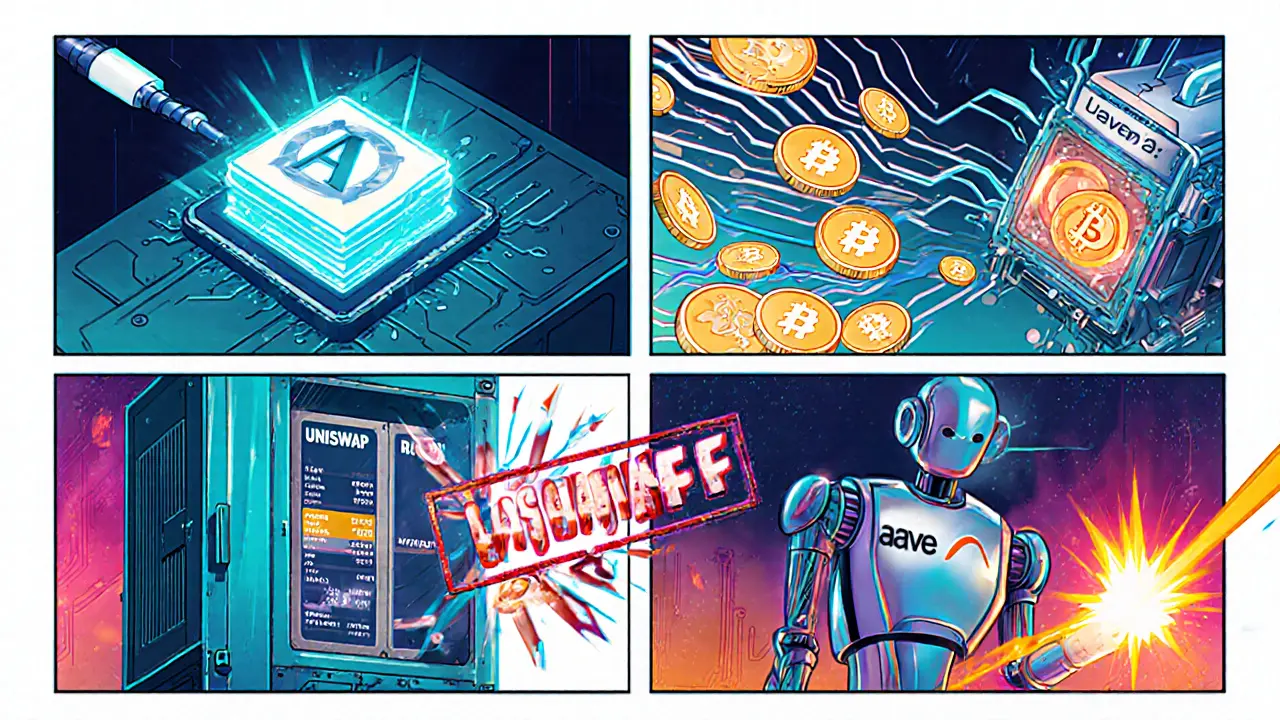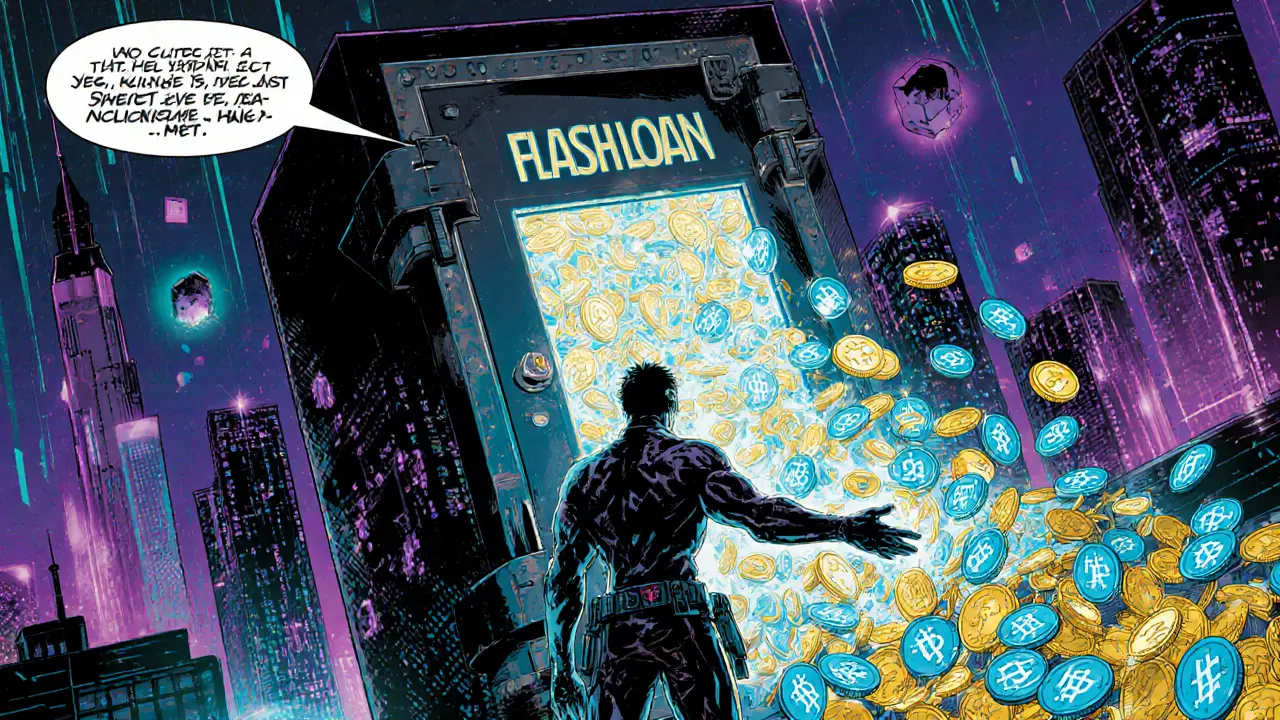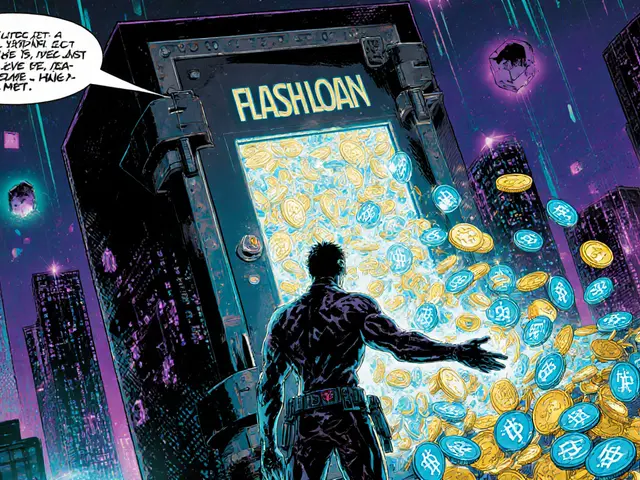Flash Loan Fee Calculator
Results Summary
Top Flash Loan Providers
Aave
0.09% fee
Lowest industry fee
dYdX
0.15% fee
Derivatives focused
Uniswap
0.30% fee
Flash swaps
Imagine borrowing millions of dollars without putting up any collateral, as long as you pay it back in the same instant. That’s the magic of flash loan providers in the DeFi world. They let developers and traders execute complex strategies-arbitrage, liquidation, collateral swaps-within a single blockchain transaction. If the loan isn’t repaid instantly, the whole operation is undone, protecting the liquidity pool.
Key Takeaways
- Flash loans are collateral‑free, single‑transaction loans enforced by smart contracts.
- Aave, dYdX and Uniswap dominate the market, while newer players like Equalizer Finance add niche features.
- Typical fees range from 0.09% to 0.3% of the borrowed amount.
- Use cases include arbitrage, debt restructuring, and liquidity provision, but the barrier to entry is high.
- Future trends point to cross‑chain support, lower gas costs, and stronger security safeguards.
What Exactly Is a Flash Loan?
A flash loan is a short‑term loan that must be borrowed and repaid within one atomic blockchain transaction. Because the transaction either fully succeeds or fully reverts, the lender’s capital stays safe even if the borrower can’t pay back.
Key attributes of a flash loan:
- Zero collateral: No upfront assets are required.
- Instant execution: The loan, strategy, and repayment happen in the same block.
- Smart‑contract enforcement: The protocol automatically rolls back if repayment fails.
How Flash Loans Work on DeFi
The process boils down to five steps:
- Borrower’s contract calls the lending pool’s
flashLoanfunction. - The pool transfers the requested assets to the borrower’s contract.
- The borrower executes its custom logic-e.g., buying low on one exchange and selling high on another.
- The contract repays the principal plus a small fee.
- If any step fails, the entire transaction is reverted, as if nothing happened.
Since the whole workflow lives inside a single transaction, gas costs can be significant, especially on busy networks like Ethereum. Developers therefore aim to keep the on‑chain logic lean and off‑load heavy computations to off‑chain services.
Major Flash Loan Providers
The ecosystem has a few clear leaders, each offering a slightly different flavor of the service.
Aave is widely regarded as the flagship flash‑loan platform. It runs on Ethereum and several Layer‑2 chains, supports dozens of assets, and charges a flat 0.09% fee on most loans.
dYdX brings flash loans to its perpetual‑trading ecosystem, focusing on derivatives and offering slightly higher fees (around 0.15%) but tighter integration with margin positions.
Uniswap introduced flash swaps, letting users borrow tokens from its liquidity pools as long as they return an equivalent value by the end of the transaction. This model is handy for token‑pair arbitrage.
Emerging players include Equalizer Finance, which focuses on algorithmic fee structures, and Port Finance, known for its cross‑chain bridges. Furucombo isn’t a lender per se; it provides a visual “drag‑and‑drop” interface to chain together flash‑loan steps, lowering the technical barrier for developers.

Comparing the Top Platforms
| Platform | Primary Network | Supported Assets | Fee (%) | Notable Feature |
|---|---|---|---|---|
| Aave | Ethereum, Polygon, Arbitrum | 30+ ERC‑20 tokens | 0.09 | Largest liquidity pool, low fee |
| dYdX | StarkEx (Layer‑2) | USDC, DAI, ETH (via derivatives) | 0.15 | Integrated with perpetual contracts |
| Uniswap | Ethereum, Optimism | All pool tokens | 0.30 (as value‑in‑kind) | Flash swaps for pair arbitrage |
| Equalizer Finance | Ethereum | 10+ stablecoins | Variable (0.08-0.12) | Dynamic fee based on pool usage |
| Port Finance | Avalanche, Solana (cross‑chain) | AVAX, SOL, USDT | 0.12 | Cross‑chain flash loans |
| Furucombo | Ethereum | Supports any Aave‑compatible asset | Platform‑dependent | Visual workflow builder |
Popular Use Cases and Associated Risks
Flash loans shine in scenarios where you need temporary, huge liquidity:
- Arbitrage: Spot price differences between DEXes (e.g., Uniswap vs. SushiSwap) and capture the spread.
- Collateral Swaps: Replace a risky collateral type with a safer one without adding extra capital.
- Debt Refinancing: Pay off an under‑collateralized loan on one protocol and open a better‑priced position on another.
- Liquidity Provision: Seed a new pool, earn fees, and withdraw instantly.
But every upside carries a downside:
- Execution risk: If your transaction runs out of gas or a price moves against you before repayment, the whole loan reverts and you lose the transaction fee.
- Market risk: Flash‑loan opportunities can evaporate in seconds; slippage can turn profit into loss.
- Security risk: Bad actors have used flash loans to exploit price oracles and cause massive liquidations. Choose platforms with robust oracle integrations.
Getting Started: Building Your First Flash Loan Contract
Below is a minimal Solidity snippet that pulls a flash loan from Aave on Ethereum. It’s deliberately simple-just enough to compile and test on a testnet.
pragma solidity ^0.8.0;
import "@aave/core-v3/contracts/flashloan/base/FlashLoanSimpleReceiverBase.sol";
import "@aave/core-v3/contracts/interfaces/IPoolAddressesProvider.sol";
contract SimpleFlash is FlashLoanSimpleReceiverBase {
constructor(IPoolAddressesProvider provider) FlashLoanSimpleReceiverBase(provider) {}
function executeFlashLoan(address asset, uint256 amount) external {
address receiver = address(this);
bytes memory params = ""; // custom data if needed
POOL.flashLoanSimple(receiver, asset, amount, params, 0);
}
function executeOperation(
address asset,
uint256 amount,
uint256 premium,
address initiator,
bytes calldata params
) external override returns (bool) {
// ---- Your strategy goes here ----
// e.g., arbitrage between Uniswap and Sushiswap
// Repay loan + fee
uint256 total = amount + premium;
IERC20(asset).approve(address(POOL), total);
return true;
}
}
Key tips for newcomers:
- Deploy on a testnet first (Goerli or Sepolia) to avoid costly mistakes.
- Use libraries like Uniswap v3-periphery for swapping within the same transaction.
- Monitor gas price spikes; high gas can erase any arbitrage profit.
Future Trends for Flash Loan Platforms
As DeFi matures, flash‑loan services are evolving in three main directions:
- Cross‑chain capability: Platforms like Port Finance are building bridges so you can borrow on Avalanche and settle on Solana, widening arbitrage horizons.
- Lower gas solutions: Layer‑2 rollups (Arbitrum, Optimism) and modular chains (Polygon zkEVM) promise sub‑$1 transaction costs, making tiny‑margin strategies viable.
- Enhanced security: New oracle designs, flash‑loan-proof AMM formulas, and real‑time monitoring tools aim to curb exploit vectors that have plagued the space.
Regulators are also watching. While flash loans themselves aren’t illegal, any misuse that manipulates markets could attract scrutiny. Providers are responding with better KYC on liquidity providers and audit‑backed contracts.
Frequently Asked Questions
Can I use flash loans without writing code?
Most platforms require a smart contract, but services like Furucombo let you drag‑and‑drop pre‑built modules, reducing the need for deep coding knowledge.
What is the typical fee for a flash loan?
Fees range from 0.08% on platforms like Equalizer Finance up to about 0.30% on Uniswap’s flash swaps. Aave’s flat 0.09% is the industry benchmark.
Do flash loans work on networks other than Ethereum?
Yes. dYdX runs on StarkEx (Layer‑2), Port Finance operates on Avalanche and Solana, and Aave supports Polygon and Arbitrum, among others.
What are the biggest security concerns?
Flash‑loan attacks often target vulnerable price oracles or badly designed AMMs. Choose platforms with audited contracts and robust oracle feeds.
Is there a minimum amount I can borrow?
Most providers set a minimum based on the asset’s liquidity, typically a few thousand dollars worth of tokens. Small‑scale tests are best done on testnets.
How do I find profitable arbitrage opportunities?
Monitor price feeds from multiple DEXes, use bots that calculate price differentials in real‑time, and ensure the spread exceeds both gas costs and the flash‑loan fee.



Jeannie Conforti
January 3 2025Flash loans are wild, but start small and test on a testnet.
tim nelson
January 3 2025If you’re just getting your feet wet, keep an eye on gas fees – they can eat up most of the arbitrage spread before you even see a profit.
Zack Mast
January 3 2025The fleeting nature of flash loans mirrors the impermanence of market sentiment; seize the moment or watch it dissolve.
Dale Breithaupt
January 3 2025When you dive into flash loans, the first thing to wrap your head around is the atomicity guarantee that the blockchain provides.
Because the whole sequence lives in a single transaction, any failure automatically reverts the state, protecting the lender.
That safety net, however, comes with a hidden cost: you have to fit all your logic, swaps, and repayments inside the gas limit of one block.
On Ethereum, even a modest arbitrage between Uniswap and SushiSwap can consume several hundred thousand gas, which translates to a few dollars at current rates.
If your profit margin is thinner than the combined fee and gas expense, the flash loan becomes a losing proposition.
Aave’s 0.09% fee is the cheapest among the major providers, but you still need to factor in the premium that the protocol adds on top of the principal.
dYdX’s 0.15% fee includes access to its perpetual contracts, which can be useful if your strategy relies on leverage beyond spot prices.
Uniswap’s flash swaps let you borrow a token pair and settle it later in the same transaction, but the implicit fee is baked into the price impact of the swap.
When you design your smart contract, keep the code path as short as possible and off‑load heavy calculations to off‑chain services that feed you the optimal trade parameters.
Testing on a Goerli or Sepolia testnet not only saves you real ETH but also gives you a sandbox to iterate on the re‑entrancy and callback logic.
Don’t forget to whitelist the token addresses you plan to use; some protocols restrict flash loans to a whitelist of highly liquid assets to avoid sandwich attacks.
Monitoring real‑time price feeds from multiple DEXes is crucial, because a few seconds of latency can wipe out the arbitrage window you were counting on.
Many traders now employ bots that watch price differentials and trigger flash loans automatically, but the bot itself must be able to sign and send a transaction within the same block.
If you’re operating on a layer‑2 like Arbitrum, the gas costs drop dramatically, opening up opportunities for smaller‑scale strategies that were previously unprofitable on L1.
Finally, always audit your contract or have a third‑party review it, because a single unchecked edge case can become an exploit vector that attackers will try to weaponize.
Rasean Bryant
January 3 2025Remember, the key to consistent gains is to let the fee margin comfortably exceed your estimated gas cost, then you’ll see positive net results more often than not.
Angie Food
January 3 2025i dont think flash loans are all that useful, most peopel just try 2 make quick cash and end up paying more in feess.
Jonathan Tsilimos
January 4 2025The prevailing consensus underscores that liquidity depth, fee structuring, and cross‑chain interoperability constitute the triad of determinants for optimal flash loan deployment in contemporary decentralized finance ecosystems.
jeffrey najar
January 4 2025Great point about testing on Goerli – I’d add that using Hardhat’s mainnet‑fork mode also lets you simulate real‑world gas prices without spending real ETH.
Rochelle Gamauf
January 4 2025While optimism is admirable, one must also acknowledge that the majority of flash‑loan exploits arise from poorly audited oracle integrations, not merely from fee structures.
Jerry Cassandro
January 4 2025Your long breakdown is spot on; I’d also suggest pulling price feeds from multiple aggregators like Chainlink and Band to mitigate oracle manipulation risk.
Parker DeWitt
January 4 2025🚀 Flash loans are like the fast‑food of DeFi – quick, cheap, but you gotta watch the calories (aka gas fees) or you'll get a stomachache! 🍔💸
Allie Smith
January 4 2025It's fascinating how flash loans democratize access to massive capital, yet they also remind us that the universe favors those who can move at the speed of light.
Lexie Ludens
January 4 2025Honestly, most of these platforms are just glorified money‑making machines for the elite; the average trader gets left with a bill and a broken heart.
Aaron Casey
January 4 2025From a technical standpoint, ensure your contract implements the IFlashLoanReceiver interface correctly, handling the `executeOperation` callback and approving the pool for the total repayment amount.